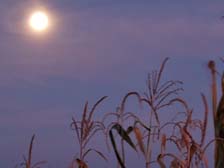The reliable return of summer solstice means the end of one year and the beginning of another in Mvskoke country.
Like other indigenous Americans, Mvskoke people “survived by knowing their natural environment well and making direct use of its surpluses. It was a land of abundance, but that abundance was only available to those who had the necessary skills,” writes J. Donald Hughes in North American Indian Ecology. “They kept track of annual cycles, naming the months after the natural changes they observed. Their lives were closely involved in nature’s rhythms, and they were conscious of this.”
 Cokv-walv Mvskoke, the Mvskoke calendar, is one way our Mvskoke ancestors preserved their understanding of natural rhythms and resources. “The Indian names for the ‘moons,’ or months, show at least a part of their detailed knowledge of the seasonal cycles and rhythms of nature: when flowers or fruits would appear, when the young of animals would be born, when the lakes would freeze, when the birds would return. . . . The Indians’ science was a blend of observation, reason, insight and nature mysticism,” which is also a good description of modern technoscience if you replace nature mysticism with the profit motive.
Cokv-walv Mvskoke, the Mvskoke calendar, is one way our Mvskoke ancestors preserved their understanding of natural rhythms and resources. “The Indian names for the ‘moons,’ or months, show at least a part of their detailed knowledge of the seasonal cycles and rhythms of nature: when flowers or fruits would appear, when the young of animals would be born, when the lakes would freeze, when the birds would return. . . . The Indians’ science was a blend of observation, reason, insight and nature mysticism,” which is also a good description of modern technoscience if you replace nature mysticism with the profit motive.
And humanity’s great transformation from grounded spirituality to transcendent greed has laid the foundation for our current environmental crisis.
I began writing “Mvskoke Country” a couple of years ago in response to this crisis. In the first installment, titled “Return to Your Roots,” I commented on the landmark symposium organized by the Mvskoke Food Sovereignty Initiative and supported by all three branches of the Muscogee (Creek) Nation government, which is now an annual event. I also mentioned the National Congress of American Indians’ 2006 resolution “Supporting a National Mandatory Program to Reduce Climate Change Pollution and Promote Renewable Energy,” which remains one of the organization’s current initiatives.
After a year covering various environmental topics with a Mvskoke angle, especially in the context of anthropogenic (human-caused) climate change, I decided last summer to focus on the traditional Mvskoke calendar.
At first glance, this might not seem like fertile ground for cultivating ecological knowledge, since the Gregorian calendar used by the dominant culture bears little connection to nature. The English names for the months, for example, are based on a jumble of Latin numbers, Roman deities, and other useless anachronisms. And you may recall that the English word calendar comes from the Latin kalendarium, “moneylender’s account book,” an etymology that speaks volumes about the prevailing attitude toward natural rhythms: “time is money,” so they say.
Not so for cokv-walv Mvskoke.
The annual round begins with posketv, called “Green Corn” in English, along with little and big months named for the harvest, Hvyuce and Hyvo-Rakko; it is a time for reaping corn and other produce that will sustain the community through the year to come. This season of meskē, “summer,” continues with a couple of months announcing another kind of ingathering, Otvwoskuce and Otvwoskv-Rakko, when ripe chestnuts were thrashed down from the branches of a majestic tree now decimated by immigrant blight.
The next season—rvfo, “winter”—opens and closes with single months marking the arrival of falling temperatures and of rising winds: Eholē and Hotvlē-Hvse. In between these transitional periods are sibling months named for the season itself, Rvfo-Rakko and Rvfo ‘Cuse, when the natural world lies dormant and rests.
The third and final season is tasahcē, “spring”; it begins with paired months named for the season, Tasahcuce and Tasahce-Rakko, as the land awakens and invites the sowing of seeds. These are followed by two months honoring plants that provide edible fruit, Kē-Hvse and Kvco-Hvse, at a time when winter stores are running low and the new crops are not yet ready for harvest. The Mvskoke year then winds down with summer solstice and posketv as the annual cycle begins again.
No money changes hands under this calendar; the only transactions specified herein are ecological, not financial. Mvskoke citizens owe no allegiance to Roman imperialists—Julius Caesar (July), Augustus (August)—or to any culture that would conquer nature.
Instead, cokv-walv Mvskoke does exactly what a calendar ought to do: it reminds us where we are in time, just as a map helps us understand where we are in space. Both schemas work best when they situate a people in a place, orienting us to the means of survival through our natural environment.
It is good to have a Mvskoke calendar for Mvskoke country.
Muscogee Nation News, July 2011
Sources:
North American Indian Ecology, by J. Donald Hughes
